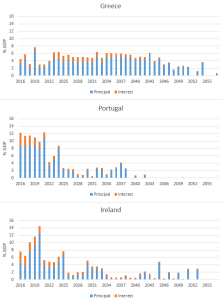In a Vox column, Daniel Dias und Mark Wright propose various measures of the Greek, Portuguese and Irish public debt burden and emphasize the large variability of these measures.
The following figure, taken from Dias and Wright, shows the scheduled principal and interest payments of Greece, Portugal and Ireland as a percentage of 2014 GDP in the respective country. Not all public debt components are accounted for.
Dias and Wright write:
[B]oth Portugal and Ireland face far larger cash flow requirements, relative to the size of their economies, than Greece for the next ten years. [A]fter this ten-year period, the required repayments on Greece’s debt will far exceed those of Portugal and Ireland, measured as a fraction of their economies. [W]hether or not we view Greece as more or less indebted than Portugal and Ireland depends on how we weigh cash flows in the near future (next ten years) versus cash flows in the far future (more than ten years).
… we can discount a country’s entire debt repayment cash flows by the interest rates embodied in their currently traded debts to obtain an estimate of the market value of a country’s debt. This assumes that the likelihood of repayment of Greece’s EFSF debt, for example, is the same as that for privately held bonds. Under these assumptions, as shown in Table 5, Greece appears to have less than half as much debt as either Portugal or Ireland. These numbers are closer to the estimates computed under the IPSAS standard, which records a debt at market value at the time of issue, and allows for the accretion of this debt if the contracted interest rate on the debt is less than the yield to maturity of the debt. This approach has the counterintuitive implication that the more likely a country is to default, the less indebted it will look.
Dias and Wright contrast a conventional face-value debt measure (the sum of the blue bars corresponding to principal repayment obligations in the figure) with more informative measures. With the latter, Greek indebtedness typically is not as high compared with the other countries as with the first measure.
See also this earlier post and this earlier post on the topic.

